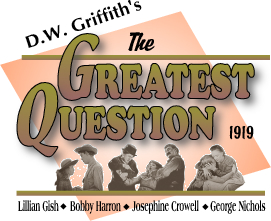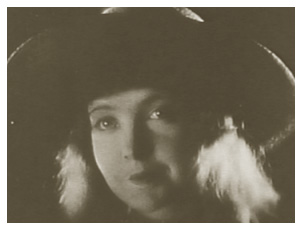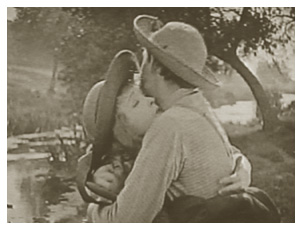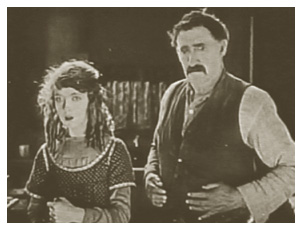

Produced by D.W. Griffith
Distributed by First National Pictures
Directed by D.W.Griffith
Released December 16, 1919
Cast: Lilllian Gish (Nellie "Little Miss Yes'm" Jarvis),
Bobby Harron (Jimmie Hilton), Josephine Crowell (Mrs. Cain), George
Nichols (Martin Cain), George Fawcett (John Hilton), Eugenie Besserer
(Mrs. Hilton), Ralph Graves (John Hilton, Jr.), TomWilson (Zeke)
When I began screening Grapevine's DVD release of "The Greatest Question," it took me back 40 years ago to the days when I saw my first D.W. Griffith feature, "True Heart Susie," from Blackhawk Films. Those were "heady" days when that box from Blackhawk would arrive in the mail, and I couldn't wait for the evening to come, pull out my special director's chair and projector table, set up the Da-Lite 48-inch screen, thread the dual 8 Elmo projector, and find myself transported to another time and place as the whirr of the projector accompanied a score by either Gaylord Carter or William Perry. No, Grapevine's release doesn't have a Gaylord Carter or William Perry score, but the original organ score by Blaine Gale sets the mood very appropriately so that I felt some of that same excitement of 40 years ago.
However, that was not all that stirred the memories. In
all these years, I had never seen "The Greatest Question,"
but the standard Griffith elements - the threatened innocent,
the beautiful pastoral scenes shot by Billy Bitzer, and the last
minute rescue - all were here reminding me of the joy I remember
from viewing "True Heart Susie" (1919), "A Romance
of Happy Valley" (1919) or "Broken Blossoms"  (1919) on Super 8mm film.
(1919) on Super 8mm film.
Unfortunately, I may have become more critical or sophisticated in my tastes over the years (I'm not sure which) because, in spite of the enjoyment of watching this film for the first time, I was also aware of several weaknesses in it. And although I remember the three previously mentioned Griffith films as virtually flawless, there may be good reason I was unable to hold this production in the same high esteem.
Lillian Gish remembered the film being made hastily as Griffith was making preparations for his move to Mamaroneck, NY. Quite possibly, Griffith could have "supervised," but not actually directed the film. Biographer Robert Henderson said it was ". . . a film that Griffith himself regarded as a potboiler." He went on to note, "It has seemed surprising to people that Griffith allowed his name to be used in connection with these First National films, in view of the fact that he had so jealously kept his name from association with lesser films. . . The reason, of course . . . was that his First National contract specified that his name be used, at least for promotional purposes. Since Griffith saw these films as merely a quick way to raise the money for his projected independence in Mamaroneck, he was quite willing to walk away from the First National films and to leave the direction in the hands of one of his assistants. . . . Griffith was now confident that anything that he made, particularly if the cost wasn't too high, would sell."(1.)
Whether this was a direct "hands on" project for Griffith or not, the story itself, although sufficiently entertaining, is not an inspired effort. The tale revolves around our heroine, Nellie Jarvis, otherwise known as "Little Miss Yes'm," who, as a child, witnesses Mr. and Mrs. Cain murder a servant girl and bury her body. Her parents, who are peddlers traveling in a wagon, don't believe her, and 10 years pass before Nellie finds herself in the same area, parents passed away, and taken in by the kindly Hiltons. The Hiltons are nearly penniless with an invalid father, a kindly mother who treats Nellie as a daughter, a son, Jimmie, who is in love with Nellie, and an older brother, John, who is killed during World War I. When the Hiltons' financial situation worsens, Nellie decides she must "hire out" to lessen their burden - and she "hires out" to the Cains. However, the years have dimmed her memory of the murder, so she does not recognize the couple - at least initially.
This, in itself, is not a bad story line and stirs our interest as we fear for Nellie's safety when she goes to work as a live-in housekeeper for the Cains. The interest is piqued even more as Martin Cain has lustful designs on Nellie, and Mrs. Cain is quick to beat Nellie mercilessly with a whip for breaking a dish.
One of the weak points in the film, though, is the spiritualism
aspect that some historians feel Griffith may have grafted into
the story in response to the popularity of psychic matters through
the likes of Sir Oliver Lodge and others at the time. This is
portrayed through the close relationship of Mrs. Hilton and her
eldest son, John, between whom there is something "no bullet
can kill." By the way, John's death is a most impressive
sequence in the film as he is topside on a submarine when a destroyer
approaches. The submarine must dive, and John is not able to reach
the hatch and get inside, thereby  drowning
at sea. No miniatures here - so, as noted, very impressive. When
both Mr. and Mrs. Hilton are about to lose their faith altogether
as penury waits at their door, they go to visit John's memorial
at the cemetery where he appears to them in a ghostly apparition,
renewing their hope. Again, this is a weak addition to the story
and fails to have any direct correlation to Nellie's plight and
only tepid connection to the Hilton's subsequent good fortune.
drowning
at sea. No miniatures here - so, as noted, very impressive. When
both Mr. and Mrs. Hilton are about to lose their faith altogether
as penury waits at their door, they go to visit John's memorial
at the cemetery where he appears to them in a ghostly apparition,
renewing their hope. Again, this is a weak addition to the story
and fails to have any direct correlation to Nellie's plight and
only tepid connection to the Hilton's subsequent good fortune.
The strongest aspect of this film, though, is the acting. Look at the lineup - Lillian Gish, Bobby Harron, George Nichols, Josephine Crowell, George Fawcett, Eugenie Besserer and Ralph Graves. Crowell is seen in a role vastly different from either the kindly mother we remember so well in "The Birth of a Nation" (1915) or the whiney mother-in-law we remember from Harold Lloyd's "Hot Water" (1923). She succeeds well as the evil Mrs. Cain, although Edward Wagenknecht referred to her grimaces as "terrible mugging." Wagenknecht went further to say, "The evil forces embodied in the Cains are so broadly conceived and projected as to be almost disgusting." (2) This viewer found that Crowell and Nichols brought a "creepiness" to the evil Cains that was very convincing and appropriately menacing to make the threat to innocent Nellie both exciting and horrifying.
Fawcett and Besserer bring their usual professional and high quality skills to the table, while Graves is lackluster in a part that, admittedly, requires little. Bobby Harron is always enjoyable, and the tender moments between him and Gish, set against a beautiful, bucolic background, are quite moving. Films such as this certainly hearken back to a lost time as we see these two innocents attempt to awkwardly express their affection for one another. In one meeting, Nellie leans toward Jimmie, obviously expecting a kiss, but when he does, she acts as if she is indignant and pulls away "angrily." We later see the two of them walking away from the camera, side by side, down a tree-lined country road - a scene worthy of a Currier and Ives painting. When Nellie is leaving to go live with the Cains, they stand next to stream, tree overhanging with leaves rustling in the wind and the sun setting with in the background. Both are sad and hold each other lovingly at the thought of being apart. The embrace is long and ends with a kiss. Nellie walks way in tears as Jimmie can only stare heartbroken at the ground. No two could exhibit the innocence of such a moment more than Gish and Harrron.
Of course, Gish IS the film from beginning to end. The close-ups
of Gish are incredibly beautiful, and, at 27 years old, she is
still able to portray the innocent, frail, young girl both convincingly
and effortlessly. Wagenknecht said of her performance, it is both
"sufficiently distinguished" and "sufficiently
lyrical." (3) Those who are familiar with "Broken Blossom,"
made just the year before, will see similarities in "The
Greatest Question." Crowell's beating of Gish with a whip
is almost a recreation of Donald Crisp's beating of Gish in "Broken
Blossoms," however, not with the emotional impact nor the
resulting catastrophe. The cross-cutting of Jimmie headed to the
Cains' home and Nellie flees to the attic to evade Martin Cain's
lascivious advances, and her pacing like an animal caught in a
trap  brings to mind the
closet scene in "Broken Blossoms."
brings to mind the
closet scene in "Broken Blossoms."
As noted, Nichols and Crowell strike an emotional chord with their villainy, and the attic scene is an especially gripping one as Nellie is barely able to pull the ladder up in time to prevent Cain from coming after her. As Nellie paces the floor beside herself with fear, we see Cain stacking boxes to reach the attic door. When he does, Nellie tries to hold it closed, obviously unsuccessfully. Cain is now in the attic, and, at the moment we believe the intensity is at its height, Mrs. Cain arrives with a gun in hand to confront both her husband and Nellie. As Nellie stands, terrified before the two, she suddenly realizes this is the couple she saw murder the girl 10 years ago. The emotional intensity of this scene is one of the film's best moments.
With any good film, all "conflicts" must be resolved, and the resolution to the Hiltons' poverty is less than inspired. Actually, we have the essence of a 19th century melodrama as they almost sell their land to an unscrupulous sharper who finds the oil on it - a discovery of which the Hiltons are unaware. Destitute, they tell the sharper to bring the papers the next day, and they'll sell the property. A last minute, accidental discovery saves them from losing their property and their impending fortune.
As one would expect, Griffith's florid, sentimental intertitles are no less prominent than in most of his early work, yet, they seem less effective here. In "The Greatest Question" they quite often come across as forced rather than adding to the beauty of a scene. For example, we see Nellie's mother pass away in her arms. An intertitle tells us, "A life flowing out to mysterious, uncharted seas." The title essentially makes no sense - "mysterious, uncharted"?? Then there follow a couple of shots of a flowing stream, and we cut back to Nellie holding her mother. This interlude interrupts the emotion of the moment rather than enhancing it.
Tom Wilson plays the black "old family retainer" - a white character actor who played roles in blackface several times during the silent era. Although there is a very mild comedic aspect to the character, Griffith could have eliminated this character and lost nothing in the story. He is, however, treated with respect by the family, and certainly by early 20th century standards, the portrayal should hopefully not offend and take away from an otherwise enjoyable film.
Of the film, William K. Everson said, "'The Greatest Question' was in many ways one of his (Griffith's) best 'lesser' movies. . . Set in Kentucky, (it) - perhaps more than any he ever made - showed just how much the people and places of Griffith's childhood meant to him, and how he tried to express that love in his films." (4)
And, for whatever shortcomings one may find in the film, critic Richard Schickel expressed that it was not without merit. "Yet if it is a failure, 'The Greatest Question' is not without interest. In its modest way, it represents an attempt, however flawed, to preserve some of the spirit of the pastorals while grafting on to the basic form material Griffith judged to have larger and more pressing interest for a contemporary audience." (5)
Minor criticisms aside, "The Greatest Question"
includes so many of those elements that make a Griffith film a
Griffith film. And, besides, Griffith, Gish, Harron and a beautifully
photographed pastoral story when the great director was still
at the height of his game - how could anyone turn that down? Thanks
to Grapevine for a good quality print with a most fitting original
score. Don't miss this one.
References
1. Henderson, Robert. D.W. Griffith: His Life and Work
(Oxford University Press, 1972)
2. Wagenknecht, Edward, and Anthony Slide. The Films of D.W.
Griffith. (Crown Publishers, New York. 1975)
3. Ibid.
4. William K. Everson. American Silent Film (Oxford University
Press, 1978)
5. Schickel, Richard. D.W. Griffith: An American Life (Simon
and Schuster, 1984)
Copyright 2013 by Tim Lussier. All rights reserved.